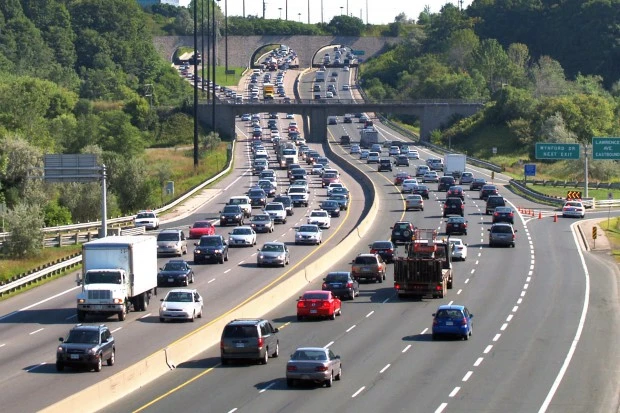So you’re sitting in traffic that’s moving at 5 miles per hour, thinking this is pretty safe because you’re barely moving, right? Well, that’s actually when a lot of accidents happen. Stop-and-go traffic is in fact way more dangerous than it looks on the surface.

The thing about heavy traffic is that you’ve got frequent braking, tons of distractions because people get bored, and driver frustration that builds up over time. This combination makes stop-and-go situations one of the most common settings for collisions – both minor fender benders and sometimes surprisingly serious crashes.
Rear-end crashes are especially common in these situations because people aren’t paying attention, following too closely, or getting distracted by their phones when traffic suddenly stops again. The person behind you might be looking at their GPS or texting and not realize traffic has come to a complete halt until it’s too late to stop.
Whether you’re dealing with your daily commute in a big city or you’re stuck on the highway because of an accident up ahead, following the right safety habits can help you avoid becoming part of the problem yourself. Here are seven specific tips to help you stay safe when traffic slows to a crawl and everyone around you is getting increasingly frustrated with the whole situation.
1. Keep a Safe Following Distance
Even when you’re only going 10 or 15 miles per hour, rear-end collisions can happen incredibly fast. Don’t follow the car in front of you too closely just because traffic is slow – leave at least one full car length or more when you’re creeping forward.
This extra space gives you crucial time to react if the car ahead suddenly hits their brakes or if traffic comes to an unexpected complete stop. That extra few feet could be the difference between a close call and an expensive accident.
Plus, leaving more space helps traffic flow better overall because you’re not constantly hitting your brakes every time the car ahead moves slightly, which creates that annoying accordion effect that makes traffic even worse.
2. Stay Alert and Minimize Distractions
It’s honestly really tempting to check your phone, mess with the radio, or just zone out when you’re barely moving for what feels like forever. But traffic conditions can change in literally an instant, even in heavy congestion.
Keep both hands on the wheel, your eyes focused on the road and the cars around you, and avoid anything that takes your attention away from driving. This includes eating, doing your makeup, or having intense phone conversations.
Remember that other drivers around you might be distracted or frustrated, which makes them unpredictable. You need to be the alert one who can react if someone does something unexpected.
3. Watch for Motorcycles and Bicycles
In heavy traffic, motorcycles often try to split lanes or weave between cars to get through faster, and bicycles might be riding close to the shoulder or even between lanes in some areas.
Check your mirrors and blind spots frequently, especially before changing lanes or even just moving forward after being completely stopped. Motorcycles and bikes can appear in spaces you wouldn’t expect regular cars to fit.
This is especially important in warmer weather when more motorcycles are on the road, or in cities where bicycle commuting is common during rush hour.
4. Use Smooth, Predictable Braking
Slamming on your brakes in stop-and-go traffic doesn’t just wear down your brake pads faster – it also seriously increases your chances of getting hit from behind by someone who wasn’t expecting such an abrupt stop.
Ease into your stops gradually and tap your brakes early to alert the driver behind you that you’re slowing down. This gives them more time to react and avoid rear-ending you.
Smooth braking also helps traffic flow better because it reduces that chain reaction of everyone hitting their brakes harder than necessary, which is part of what makes traffic jams worse.
5. Keep Your Foot on the Brake at Full Stops
When you’re completely stopped in traffic, keep your foot firmly on the brake pedal to make sure your brake lights stay on. This is a simple but really important signal to drivers behind you that you’re not moving.
Without those brake lights, especially in bright sunlight or poor weather conditions, the car behind you might not realize you’re stopped until they’re too close to stop safely themselves.
This is especially crucial when you’re stopped on a highway or in fast-moving traffic that suddenly comes to a halt, because the speed differential can be really dangerous.
6. Avoid Unnecessary Lane Changes
Constantly changing lanes in heavy traffic rarely actually gets you to your destination any faster, but it definitely raises your accident risk every single time you move over.
Stick to one lane when possible and only change lanes when it’s clearly safer or absolutely necessary, like when you need to avoid a blocked lane or take your exit.
Every lane change in heavy traffic requires other drivers to adjust, and with everyone already frustrated and potentially distracted, those adjustments don’t always go smoothly.
7. Watch for Road Rage Including Your Own
Stop-and-go traffic is frustrating for literally everyone, and that frustration can lead to poor decision-making and aggressive driving that makes dangerous situations even worse.
Stay calm, avoid aggressive driving behaviors like tailgating or cutting people off, and definitely don’t engage with drivers who are being rude or aggressive toward you.
Keep your emotions in check and remember that a level head will keep you way safer than any defensive driving maneuver ever could. Getting angry or trying to “teach someone a lesson” in traffic just isn’t worth the risk.
Conclusion
Stop-and-go traffic is honestly just an unavoidable part of driving in most places, but it definitely doesn’t have to be unsafe if you approach it with the right mindset and habits.
By staying alert, maintaining proper following distance, and driving in a predictable way that other drivers can anticipate, you’ll significantly reduce your risk of collisions and maybe even make the slow crawl a little bit smoother for everyone around you who’s stuck in the same situation.
